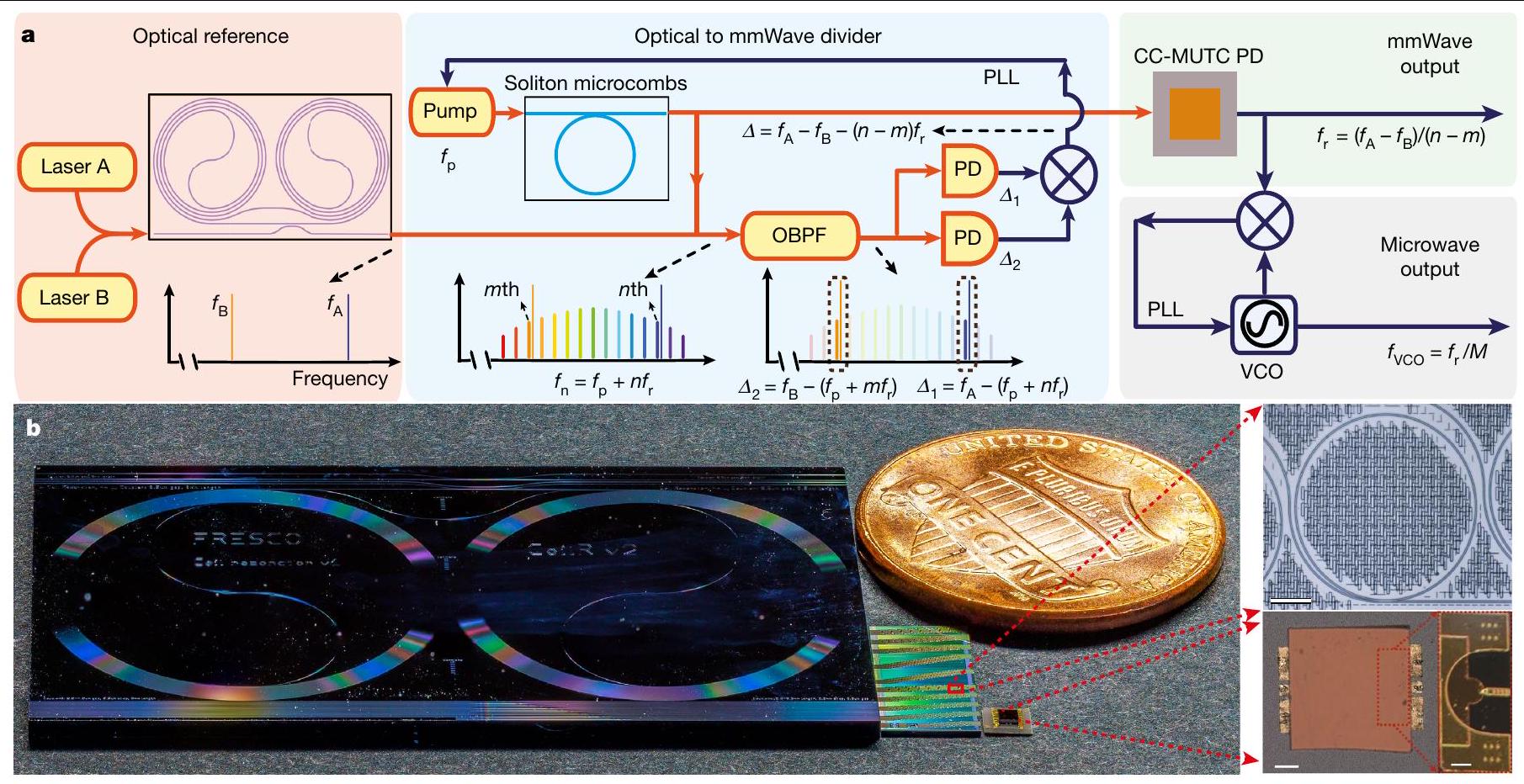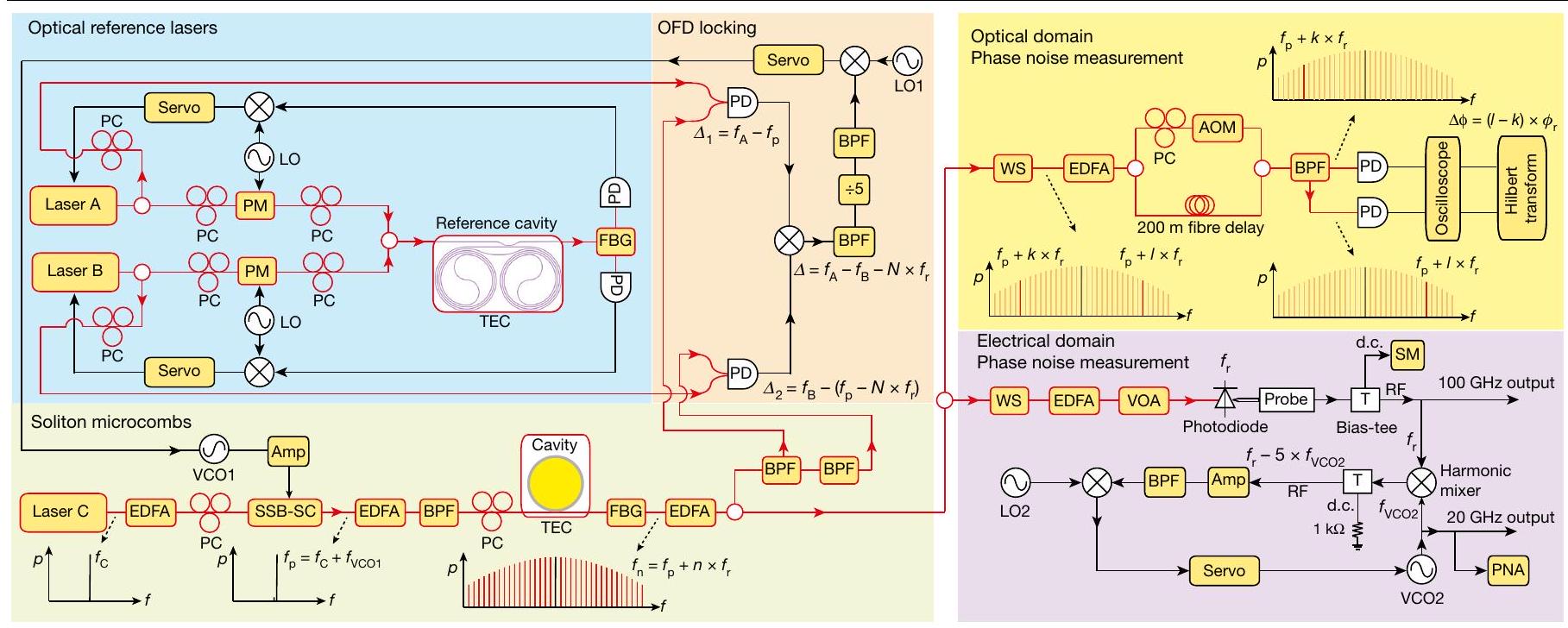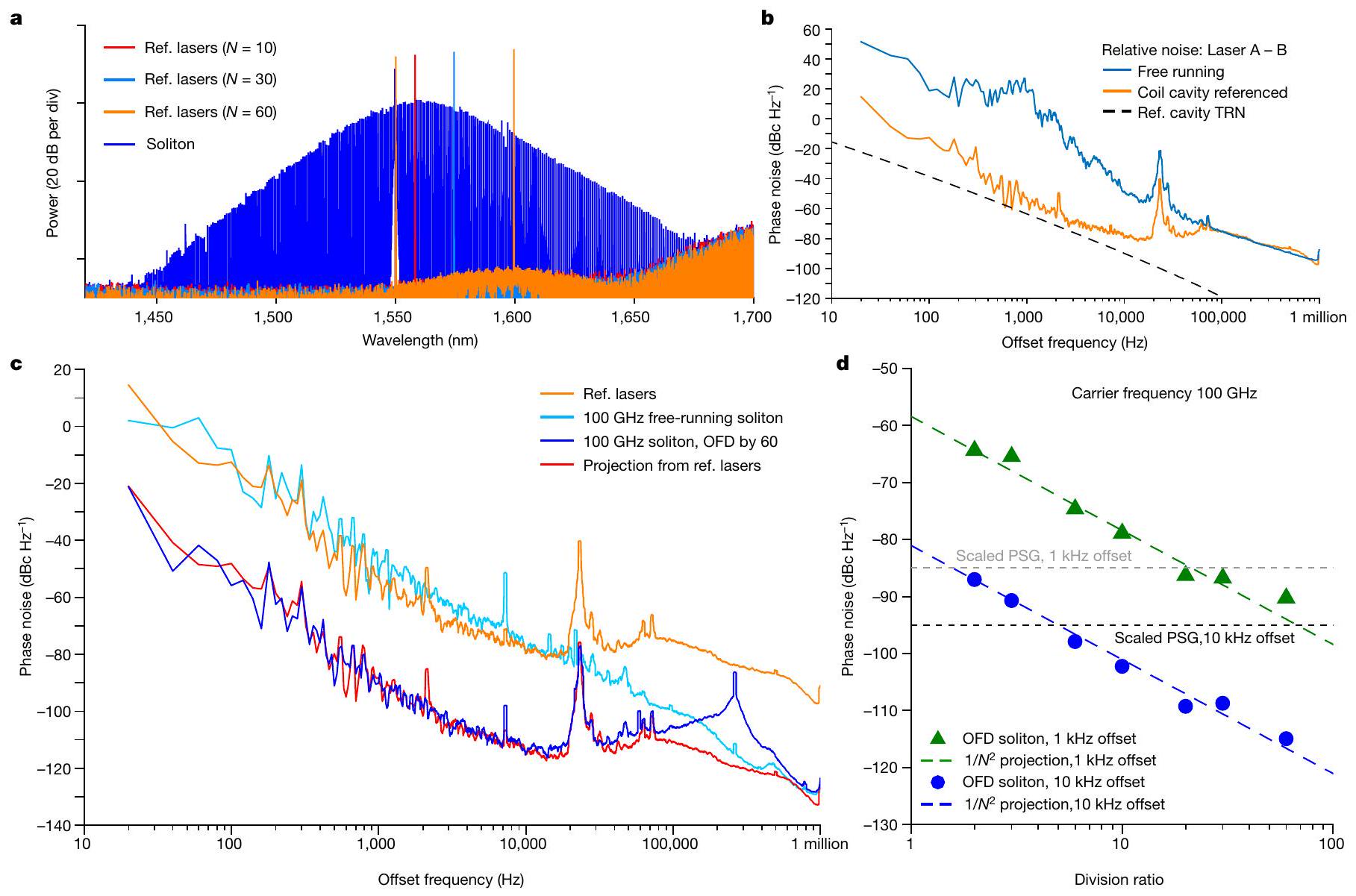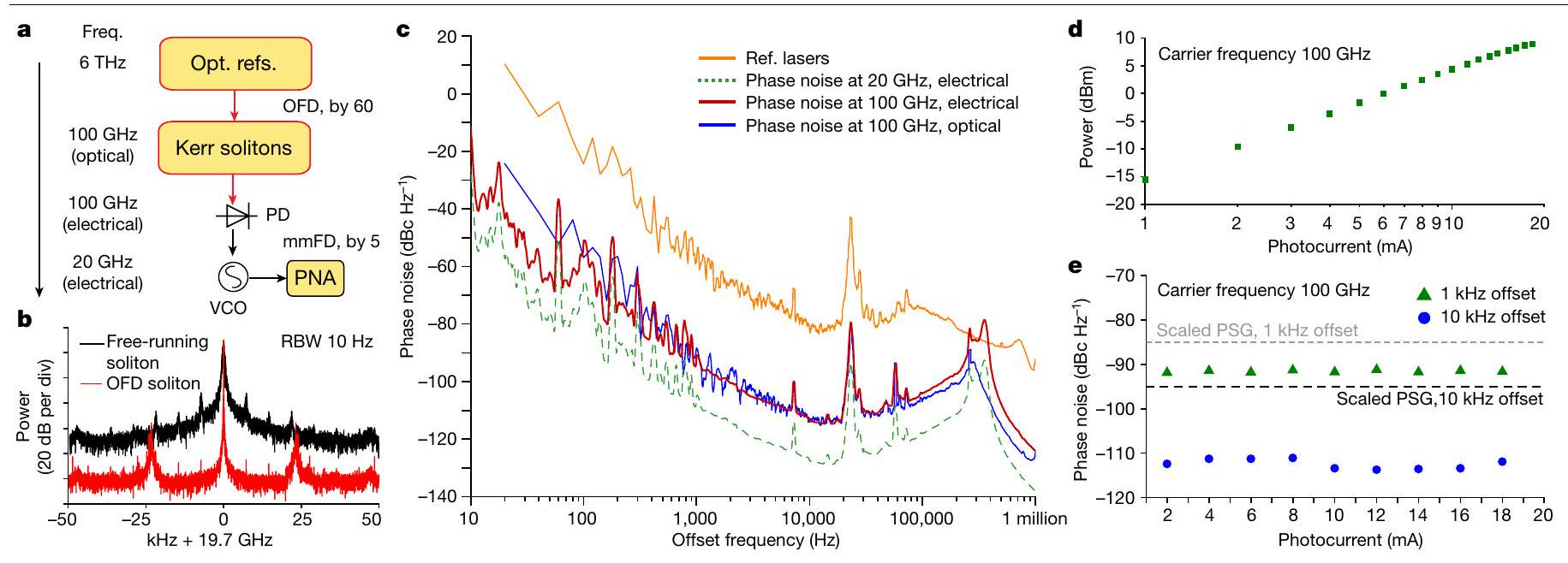DOI: https://doi.org/10.1038/s41586-024-07057-0
PMID: https://pubmed.ncbi.nlm.nih.gov/38448598
تاريخ النشر: 2024-03-06
التقسيم الترددي البصري المتكامل لتوليد الموجات الدقيقة والموجات المليمترية
تاريخ الاستلام: 21 يوليو 2023
تم القبول: 10 يناير 2024
نُشر على الإنترنت: 6 مارس 2024
الوصول المفتوح
(أ) التحقق من التحديثات
الملخص
يمكن أن يؤدي توليد الموجات الميكروية والموجات المليمترية ذات الضوضاء المنخفضة للغاية في منصات مصغرة قائمة على الرقائق إلى تحويل أنظمة الاتصالات والرادار والاستشعار.
على مقياس السنتيمتر

لقد تم إظهار المراجع البصرية المعتمدة على الألياف الطويلة مؤخرًا جدًا
عرض النطاق الخدمي 90 كيلوهرتز. يمكن ضبط أطوال موجاتهم بين

التحكم في تردد VCO. إن ضبط تردد VCO يضبط مباشرة تردد ليزر المضخة، الذي بدوره يضبط معدل تكرار السوليتون من خلال تأثيرات انزياح التردد الذاتي لرمان وتأثيرات ارتداد الموجة المشتتة.
يتم قياس ضوضاء اختلافات الطور الخاصة بهم، وقسمتها على

ميكروكومبز السوليتون الحرة (أزرق فاتح)، معدل تكرار السوليتون بعد OFD مع نسبة تقسيم 60 (أزرق) ومعدل التكرار المتوقع مع نسبة تقسيم 60 (أحمر). د، ضوضاء طور معدل تكرار السوليتون عند ترددات إزاحة 1 و10 كيلوهرتز مقابل نسبة تقسيم OFD. يتم عرض توقعات OFD بخطوط منقطة ملونة.
تم تطويره لتقسيم نطاق 100 جيجاهرتز من الموجات المليمترية إلى 20 جيجاهرتز من الموجات الدقيقة بشكل متماسك، والتي يمكن قياسها مباشرة على محلل ضوضاء الطور (الشكل 4أ).

في الألياف الضوئية بطول 200 متر في التداخل، وبالتالي تنتج ضوضاء الطور أعلى من تلك التي تم قياسها بالطريقة الكهربائية.
أخيرًا، يتم قياس ضوضاء الطور في الموجات المليمترية والطاقة مقابل تيار فوتو كاشف MUTC من 1 إلى 18.3 مللي أمبير عند جهد -2 فولت من خلال تغيير قوة الإضاءة الضوئية على الكاشف. على الرغم من أن الطاقة في الموجات المليمترية تزداد مع تيار الفوتو (الشكل 4د)، إلا أن ضوضاء الطور في الموجات المليمترية تبقى تقريبًا كما هي لجميع تيارات الفوتو المختلفة (الشكل 4هـ). وهذا يشير إلى أنه يمكن تحقيق ضوضاء طور منخفضة وطاقة عالية في نفس الوقت. الطاقة المحققة البالغة 9 ديسيبل ميلي واط هي واحدة من أعلى الطاقات التي تم الإبلاغ عنها على الإطلاق عند تردد 100 جيجاهرتز لمذبذبات ضوئية.
ملخص
مطابقة بعض من أفضل مذبذبات OFD البصرية بالجملة
المحتوى عبر الإنترنت
- كوينيغ، س. وآخرون. نظام اتصالات لاسلكي تحت تيراهيرتز بمعدل بيانات مرتفع. نات. فوتونيكس 7، 977-981 (2013).
- غيلفي، ب. وآخرون. نظام رادار متماسك يعتمد بالكامل على الفوتونيات. ناتشر 507، 341-345 (2014).
- لونغ، د. وأولابي، ف. رادار الميكروويف والاستشعار عن بعد بالأشعة تحت الحمراء (أرتك، 2015).
- فورتييه، ت. م. وآخرون. توليد ميكروويف فائق الاستقرار عبر تقسيم التردد البصري. نات. فوتونيكس 5، 425-429 (2011).
- شيا، إكس. وآخرون. إشارات ميكروويف ضوئية مع ضوضاء توقيت مطلقة بمستوى زبتوثانية. نات. فوتونيكس 11، 44-47 (2017).
- ناكامورا، ت. وآخرون. تحويل الترددات الضوئية المتماسكة إلى ترددات الميكروويف مع
عدم الاستقرار. العلوم 368، 889-892 (2020). - لي، ج. وفاهالا، ك. مذبذبات ميكروويف ضوئية صغيرة الحجم ذات ضوضاء طور منخفضة للغاية في نطاقات X-Ka. أوبتيكا 10، 33-34 (2023).
- باكيت، م. و. وآخرون. 422 مليون عامل جودة داخلي لمذبذب متكامل ذو خطة مع عرض خطي أقل من ميغاهرتز. نات. كوميونيك. 12، 934 (2021).
- ليو، ك. وآخرون. ليزر بعرض خط متكامل 36 هرتز يعتمد على رنان لولبي ضوئي متكامل بطول 4.0 م. أوبتيكا 9، 770-775 (2022).
- براش، ف. وآخرون. كومب التردد البصري القائم على رقاقة ضوئية باستخدام إشعاع تشيرينكوف السوليتون. ساينس 351، 357-360 (2016).
- كيبنبرغ، ت. ج.، غايتا، أ. ل.، ليبسون، م. & غوروديتسكي، م. ل. السوليتونات الكيرّية المبددة في الميكرو ريزوناتورات البصرية. ساينس 361، eaan8083 (2018).
- وانغ، ب. وآخرون. نحو منصة فوتونية متكاملة ذات طاقة عالية وتماسك عالي مع سوليتونات التجاويف الدقيقة. علوم الضوء. تطبيقات 10، 4 (2021).
- شيانغ، سي.، جين، و. وباويرز، جي. إي. الدوائر المتكاملة الضوئية السلبية والنشطة من نيتريد السيليكون: الاتجاهات والآفاق. أبحاث الفوتونيات 10، A82-A96 (2022).
- ماتي، د. وآخرون.
ليزرات بعرض خط أقل من 10 ميغاهرتز. فيزيكال ريفيو ليترز 118، 263202 (2017). - كيتلاوس، إ. أ. وآخرون. مُركب هيتردين ضوئي منخفض الضوضاء وتطبيقه في رادار المليمتر. نات. كوميونيك. 12، 4397 (2021).
- لي، ج.، لي، هـ. وفاهالا، ك. جهاز تخليق ميكروويف باستخدام مذبذب بريلوان على الشريحة. نات. كوميون. 4، 2097 (2013).
- غوندافارابو، س. وآخرون. ليزر بريلوان المتكامل ضوئيًا بعرض خط أساسي تحت الهرتز. نات. فوتونيكس 13، 60-67 (2019).
- هير، ت. وآخرون. السوليتونات الزمنية في الميكرو ريزوناتور البصرية. نات. فوتون. 8، 145-152 (2014).
- ليانغ، و. وآخرون. مذبذب فوتوني بتردد كير عالي النقاء الطيفي. نات. كوميونيك. 6، 7957 (2015).
- Yi، X. وآخرون. موجات متشتتة أحادية الوضع وديناميات ميكروكومب السوليتون. نات. كوميونيك. 8، 14869 (2017).
- ليو، ج. وآخرون. توليد الموجات الميكروية الضوئية في نطاق X ونطاق K باستخدام ميكروكومب سوليتون المتكامل. نات. فوتونيكس 14، 486-491 (2020).
- باي، ي. وآخرون. كومب تردد سوليتون بريلوان-كير في ريزوناتور بصري صغير. فيز. ريف. ليت. 126، 063901 (2021).
- ياو، ل. وآخرون. مذبذات ميكروويف سوليتون باستخدام ميكرو رنينات بصرية ضخمة بمليار Q. أوبتيكا 9، 561-564 (2022).
- ماتسكو، أ. ب.، سافشينكوف، أ. أ.، يو، ن. ومالكي، ل. رنانات وضعية الهمس كمراجع تردد. I. القيود الأساسية. مجلة جمعية البصريات الأمريكية B 24، 1324-1335 (2007).
- لي، هـ. وآخرون. رنانات لولبية لتثبيت تردد الليزر على الرقاقة. نات. كوم. 4، 2468 (2013).
- جين، و. وآخرون. ليزر أشباه الموصلات بعرض خط هيرتز باستخدام ميكرو ريزوناتور عالي الجودة جاهز لتقنية CMOS. نات. فوتونيكس 15، 346-353 (2021).
- لي، ب. وآخرون. الوصول إلى تماسك ليزر الألياف في الفوتونيات المتكاملة. رسالة أوبتيكس. 46، 5201-5204 (2021).
- بلومنتال، د. ج.، هايديمان، ر.، غويزبرك، د.، لينسي، أ. ورويلوفزن، ج. نيتريد السيليكون في فوتونيات السيليكون. محاضر IEEE 106، 2209-2231 (2018).
- سوان، و. س.، باومان، إ.، جورجيتا، ف. ر. ونيو بيري، ن. ر. توليد الموجات الميكروية مع ضوضاء طور متبقية منخفضة من ليزر ألياف فمتوثانية مع معدل تعديل كهربائي بصري داخل التجويف. أوبت. إكسبريس 19، 24387-24395 (2011).
- تسوموتو، ت. وآخرون. مذبذب موجات ملليمترية بتردد 300 غيغاهرتز مرجعي بصريًا. نات. فوتونيكس 15، 516-522 (2021).
- كوان، د.، جونغ، د.، جيون، إ.، لي، هـ. وكيم، ج. توليد ميكروويف فائق الاستقرار ونبضات سوليتون من مشط ميكروويف مستقر ضوئيًا. نات. كوميونيك. 13، 381 (2022).
- تشانغ، س. وآخرون. توليد موجات تيراهيرتز باستخدام ميكروكومب سوليتون. أوبت. إكسبريس 27، 35257-35266 (2019).
- رابابورت، ت. س. وآخرون. الاتصالات اللاسلكية والتطبيقات فوق 100 غيغاهرتز: الفرص والتحديات للجيل السادس وما بعده. IEEE Access 7، 78729-78757 (2019).
- كليفيتي، سي. وآخرون. تجربة VLBI باستخدام ساعة ذرية عن بُعد عبر رابط ألياف متماسكة. تقارير علمية 7، 40992 (2017).
- شيا، إكس. وآخرون. تحسين كفاءة تحويل الطاقة في الكاشفات الضوئية عالية الأداء من خلال الربط العكسي على الماس. أوبتيكا 1، 429-435 (2014).
- سون، ك. وبلينغ، أ. كاشفات ضوئية عالية السرعة لفيزياء الميكروويف. العلوم التطبيقية 9، 623 (2019).
- مورتون، ب. أ. ومورتون، م. ج. ليزر هجين عالي القدرة ومنخفض الضوضاء للغاية لتقنية الميكروويف والفوتونيات البصرية. مجلة تكنولوجيا الضوء 36، 5048-5057 (2018).
- ستون، ج. ر. وآخرون. الديناميات الحرارية وغير الخطية للسلطانات المبددة في مشط ترددات كير-ميكرو ريزوناتور. فيز. ريف. ليتر. 121، 063902 (2018).
- كوان، د. وآخرون. طريقة قياس عالية الدقة بدون مرجع لطيف اهتزاز التوقيت لأمشاط التردد البصري. تقارير العلوم 7، 40917 (2017).
- تشاو، ي. وآخرون. تقسيم التردد البصري بالكامل على الرقاقة باستخدام ليزر واحد. ناتشر https:// doi.org/10.1038/s41586-024-07136-2 (2024).
- كوديلين، إ. وآخرون. مذبذب ميكروويف منخفض الضوضاء قائم على رقاقة ضوئية. الطبيعةhttps://doi. org/10.1038/s41586-024-07058-z (2024).
- إشيباشي، ت.، كوداما، س.، شيميزو، ن. س. ن. وفوروتا، ت. ف. ت. استجابة عالية السرعة لثنائيات ضوئية ذات حامل واحد. مجلة اليابان للفيزياء التطبيقية 36، 6263 (1997).
- بيلينغ، أ.، شيا، إكس. وكامبل، ج. سي. ثنائيات ضوئية عالية القدرة وعالية الخطية. أوبتيكا 3، 328-338 (2016).
- لي، ق. وآخرون. ثنائي الفينيل المربوط بتقنية الفليب تشيب عالي القدرة مع عرض نطاق 110 جيجاهرتز. مجلة تكنولوجيا الضوء 34، 2139-2144 (2016).
- Guo، ج. وآخرون. ليزر قائم على الرقاقة مع عرض خط متكامل 1 هيرتز. Sci. Adv. 8، eabp9006 (2022).
- لي، هـ. وآخرون. رنان ويدج عالي الجودة محفور كيميائيًا على شريحة سيليكون. نات. فوتون. 6، 369-373 (2012).
- سبنسر، د. ت. وآخرون. جهاز توليد ترددات بصرية باستخدام الفوتونيات المتكاملة. ناتشر 557، 81-85 (2018).
- ليو، ج. وآخرون. التحكم الكهروضغطي الأحادي في ميكروكومبات السوليتون. الطبيعة 583، 385-390 (2020).
- وانغ، ج.، ليو، ك.، هارينغتون، م. و.، رودي، ر. كيو. وبلومنتال، د. ج. موصل ميكرو ريزوناتور بصري من نيتريد السيليكون للتحكم البصري. أوبت. إكسبريس 30، 31816-31827 (2022).
- مورتون، ب. أ. وآخرون. ليزر متكامل قابل للتعديل (ICTL) مع ضبط عرض نطاق ترددي فائق وعرض خط لورنتزي أقل من 100 هرتز. ج. تكنولوجيا الضوء. 40، 1802-1809 (2022).
- ستيرن، ب.، جي، إكس.، أوكاواتشي، ي.، غايتا، أ. ل. وليبسون، م. مولد مشط تردد متكامل يعمل بالبطارية. ناتشر 562، 401-405 (2018).
- شيانغ، سي. وآخرون. ميكروكومبات سوليترون بالليزر مدمجة بشكل غير متجانس على السيليكون. ساينس 373، 99-103 (2021).
- هيلغاسون، أ. ب. وآخرون. تجاوز كفاءة التحويل غير الخطية لميكروكومب السوليتون. نات. فوتونيكس 17، 992-999 (2023).
(ج) المؤلفون 2024
المقالة
توفر البيانات
توفر الشيفرة
هذا المستند هي آراء المؤلفين ولا ينبغي تفسيرها على أنها تمثل السياسات الرسمية لـ DARPA أو ARPA-E أو الحكومة الأمريكية.
معلومات إضافية
المعلومات التكميلية النسخة الإلكترونية تحتوي على مواد تكميلية متاحة على https://doi.org/10.1038/s41586-024-07057-0.
يجب توجيه المراسلات وطلبات المواد إلى دانيال ج. بلومنتال أو شو يي.
معلومات مراجعة الأقران تشكر ناتشر المراجعين المجهولين على مساهمتهم في مراجعة الأقران لهذا العمل. تقارير مراجعي الأقران متاحة.
معلومات إعادة الطبع والأذونات متاحة على http://www.nature.com/reprints.
DOI: https://doi.org/10.1038/s41586-024-07057-0
PMID: https://pubmed.ncbi.nlm.nih.gov/38448598
Publication Date: 2024-03-06
Integrated optical frequency division for microwave and mmWave generation
Received: 21 July 2023
Accepted: 10 January 2024
Published online: 6 March 2024
Open access
(A) Check for updates
Abstract
The generation of ultra-low-noise microwave and mmWave in miniaturized, chip-based platforms can transform communication, radar and sensing systems
at centimetre-scale

long-fibre-based optical references has been shown very recently
servo bandwidth of 90 kHz . Their wavelengths can be tuned between

control of the VCO frequency. The tuning of VCO frequency directly tunes the pump laser frequency, which then tunes the soliton repetition rate through Raman self-frequency shift and dispersive wave recoil effects
noise of their phase differences is measured, and its division by

free-running soliton microcombs (light blue), soliton repetition rate after OFD with a division ratio of 60 (blue) and the projected repetition rate with 60 division ratio (red). d, Soliton repetition rate phase noise at 1 and 10 kHz offset frequencies versus OFD division ratio. The projections of OFD are shown with coloured dashed lines.
developed to coherently divide down the 100 GHz mmWave to 20 GHz microwave, which can then be directly measured on a phase noise analyser (Fig. 4a).

in the 200 m optical fibre in the interferometry and thus yield phase noise higher than that measured with the electrical method.
Finally, the mmWave phase noise and power are measured versus the MUTC PD photocurrent from 1 to 18.3 mA at -2 V bias by varying the illuminating optical power on the PD. Although the mmWave power increases with the photocurrent (Fig. 4d), the phase noise of the mmWave remains almost the same for all different photocurrents (Fig. 4e). This suggests that low phase noise and high power are simultaneously achieved. The achieved power of 9 dBm is one of the highest powers ever reported at 100 GHz frequency for photonic oscillators
Summary
match some of the best bulk optical OFD oscillators
Online content
- Koenig, S. et al. Wireless sub-THz communication system with high data rate. Nat. Photonics 7, 977-981 (2013).
- Ghelfi, P. et al. A fully photonics-based coherent radar system. Nature 507, 341-345 (2014).
- Long, D. & Ulaby, F. Microwave Radar and Radiometric Remote Sensing (Artech, 2015).
- Fortier, T. M. et al. Generation of ultrastable microwaves via optical frequency division. Nat. Photonics 5, 425-429 (2011).
- Xie, X. et al. Photonic microwave signals with zeptosecond-level absolute timing noise. Nat. Photonics 11, 44-47 (2017).
- Nakamura, T. et al. Coherent optical clock down-conversion for microwave frequencies with
instability. Science 368, 889-892 (2020). - Li, J. & Vahala, K. Small-sized, ultra-low phase noise photonic microwave oscillators at X-Ka bands. Optica 10, 33-34 (2023).
- Puckett, M. W. et al. 422 million intrinsic quality factor planar integrated all-waveguide resonator with sub-MHz linewidth. Nat. Commun. 12, 934 (2021).
- Liu, K. et al. 36 Hz integral linewidth laser based on a photonic integrated 4.0 m coil resonator. Optica 9, 770-775 (2022).
- Brasch, V. et al. Photonic chip-based optical frequency comb using soliton Cherenkov radiation. Science 351, 357-360 (2016).
- Kippenberg, T. J., Gaeta, A. L., Lipson, M. & Gorodetsky, M. L. Dissipative Kerr solitons in optical microresonators. Science 361, eaan8083 (2018).
- Wang, B. et al. Towards high-power, high-coherence, integrated photonic mmwave platform with microcavity solitons. Light Sci. Appl. 10, 4 (2021).
- Xiang, C., Jin, W. & Bowers, J. E. Silicon nitride passive and active photonic integrated circuits: trends and prospects. Photonics Res. 10, A82-A96 (2022).
- Matei, D. et al.
lasers with sub-10 MHz linewidth. Phys. Rev. Lett. 118, 263202 (2017). - Kittlaus, E. A. et al. A low-noise photonic heterodyne synthesizer and its application to millimeter-wave radar. Nat. Commun. 12, 4397 (2021).
- Li, J., Lee, H. & Vahala, K. J. Microwave synthesizer using an on-chip Brillouin oscillator. Nat. Commun. 4, 2097 (2013).
- Gundavarapu, S. et al. Sub-Hertz fundamental linewidth photonic integrated Brillouin laser. Nat. Photonics 13, 60-67 (2019).
- Herr, T. et al. Temporal solitons in optical microresonators. Nat. Photon. 8, 145-152 (2014).
- Liang, W. et al. High spectral purity Kerr frequency comb radio frequency photonic oscillator. Nat. Commun. 6, 7957 (2015).
- Yi, X. et al. Single-mode dispersive waves and soliton microcomb dynamics. Nat. Commun. 8, 14869 (2017).
- Liu, J. et al. Photonic microwave generation in the X – and K -band using integrated soliton microcombs. Nat. Photonics 14, 486-491 (2020).
- Bai, Y. et al. Brillouin-Kerr soliton frequency combs in an optical microresonator. Phys. Rev. Lett. 126, 063901 (2021).
- Yao, L. et al. Soliton microwave oscillators using oversized billion Q optical microresonators. Optica 9, 561-564 (2022).
- Matsko, A. B., Savchenkov, A. A., Yu, N. & Maleki, L. Whispering-gallery-mode resonators as frequency references. I. Fundamental limitations. J. Opt. Soc. Am. B 24, 1324-1335 (2007).
- Lee, H. et al. Spiral resonators for on-chip laser frequency stabilization. Nat. Commun. 4, 2468 (2013).
- Jin, W. et al. Hertz-linewidth semiconductor lasers using CMOS-ready ultra-high-Q microresonators. Nat. Photonics 15, 346-353 (2021).
- Li, B. et al. Reaching fiber-laser coherence in integrated photonics. Opt. Lett. 46, 5201-5204 (2021).
- Blumenthal, D. J., Heideman, R., Geuzebroek, D., Leinse, A. & Roeloffzen, C. Silicon nitride in silicon photonics. Proc. IEEE 106, 2209-2231 (2018).
- Swann, W. C., Baumann, E., Giorgetta, F. R. & Newbury, N. R. Microwave generation with low residual phase noise from a femtosecond fiber laser with an intracavity electro-optic modulator. Opt. Express 19, 24387-24395 (2011).
- Tetsumoto, T. et al. Optically referenced 300 GHz millimetre-wave oscillator. Nat. Photonics 15, 516-522 (2021).
- Kwon, D., Jeong, D., Jeon, I., Lee, H. & Kim, J. Ultrastable microwave and soliton-pulse generation from fibre-photonic-stabilized microcombs. Nat. Commun. 13, 381 (2022).
- Zhang, S. et al. Terahertz wave generation using a soliton microcomb. Opt. Express 27, 35257-35266 (2019).
- Rappaport, T. S. et al. Wireless communications and applications above 100 GHz : opportunities and challenges for 6 G and beyond. IEEE Access 7, 78729-78757 (2019).
- Clivati, C. et al. A VLBI experiment using a remote atomic clock via a coherent fibre link. Sci. Rep. 7, 40992 (2017).
- Xie, X. et al. Improved power conversion efficiency in high-performance photodiodes by flip-chip bonding on diamond. Optica 1, 429-435 (2014).
- Sun, K. & Beling, A. High-speed photodetectors for microwave photonics. Appl. Sci. 9, 623 (2019).
- Morton, P. A. & Morton, M. J. High-power, ultra-low noise hybrid lasers for microwave photonics and optical sensing. J. Lightwave Technol. 36, 5048-5057 (2018).
- Stone, J. R. et al. Thermal and nonlinear dissipative-soliton dynamics in Kerr-microresonator frequency combs. Phys. Rev. Lett. 121, 063902 (2018).
- Kwon, D. et al. Reference-free, high-resolution measurement method of timing jitter spectra of optical frequency combs. Sci. Rep. 7, 40917 (2017).
- Zhao, Y. et al. All-optical frequency division on-chip using a single laser. Nature https:// doi.org/10.1038/s41586-024-07136-2 (2024).
- Kudelin, I. et al. Photonic chip-based low-noise microwave oscillator. Nature https://doi. org/10.1038/s41586-024-07058-z (2024).
- Ishibashi, T., Kodama, S., Shimizu, N. S. N. & Furuta, T. F. T. High-speed response of uni-traveling-carrier photodiodes. Jpn. J. Appl. Phys. 36, 6263 (1997).
- Beling, A., Xie, X. & Campbell, J. C. High-power, high-linearity photodiodes. Optica 3, 328-338 (2016).
- Li, Q. et al. High-power flip-chip bonded photodiode with 110 GHz bandwidth. J. Light. Technol. 34, 2139-2144 (2016).
- Guo, J. et al. Chip-based laser with 1-Hertz integrated linewidth. Sci. Adv. 8, eabp9006 (2022).
- Lee, H. et al. Chemically etched ultrahigh-Q wedge-resonator on a silicon chip. Nat. Photon. 6, 369-373 (2012).
- Spencer, D. T. et al. An optical-frequency synthesizer using integrated photonics. Nature 557, 81-85 (2018).
- Liu, J. et al. Monolithic piezoelectric control of soliton microcombs. Nature 583, 385-390 (2020).
- Wang, J., Liu, K., Harrington, M. W., Rudy, R. Q. & Blumenthal, D. J. Silicon nitride stress-optic microresonator modulator for optical control applications. Opt. Express 30, 31816-31827 (2022).
- Morton, P. A. et al. Integrated coherent tunable laser (ICTL) with ultra-wideband wavelength tuning and sub-100 Hz Lorentzian linewidth. J. Light. Technol. 40, 1802-1809 (2022).
- Stern, B., Ji, X., Okawachi, Y., Gaeta, A. L. & Lipson, M. Battery-operated integrated frequency comb generator. Nature 562, 401-405 (2018).
- Xiang, C. et al. Laser soliton microcombs heterogeneously integrated on silicon. Science 373, 99-103 (2021).
- Helgason, Ó. B. et al. Surpassing the nonlinear conversion efficiency of soliton microcombs. Nat. Photonics 17, 992-999 (2023).
(c) The Author(s) 2024
Article
Data availability
Code availability
this document are those of the authors and should not be interpreted as representing official policies of DARPA, ARPA-E or the US Government.
Additional information
Supplementary information The online version contains supplementary material available at https://doi.org/10.1038/s41586-024-07057-0.
Correspondence and requests for materials should be addressed to Daniel J. Blumenthal or Xu Yi.
Peer review information Nature thanks the anonymous reviewers for their contribution to the peer review of this work. Peer reviewer reports are available.
Reprints and permissions information is available at http://www.nature.com/reprints.
